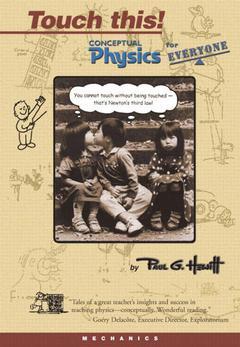Description
Touch this! conceptual physics for everyone
Author: HEWITT Paul
Language: English
Approximative price 31.60 €
Subject to availability at the publisher.
Add to cart
Publication date: 09-2002
200 p. · 24.1x16.5 cm · Paperback
200 p. · 24.1x16.5 cm · Paperback
Description
/li>Contents
/li>
If we teach children the basic laws of science correctly, it will build a strong foundation for learning science in the future. This book is Paul Hewitt's vision of how to explain these basic concepts to children. Only the attuned ear can fully appreciate a Beethoven symphony, only the cultivated palette can fully appreciate a fine Bordeaux, and only the mind that is familiar with the rules can fully appreciate the physical world. How fortunate is a child who is influenced by a knowledgeable teacher. Therefore, a knowledgeable teacher can be akin to a fine chef who supplies savory and healthful ingredients to what might have otherwise be a bland soup. This book was written for a general audience and assumes no prior knowledge of physics or mathematics. It contains author-drawn cartoons explain difficult concepts and make learning physics fun and less intimidating and explains such concepts as speed, friction, gravity, energy, and motion.
1. Being in Equilibrium. Equilibrium. Vectors. The Sailboat. Tension, Compression, Arches, and Domes. 2. Linear Motion. Speed. Speed is Relative. Velocity. The Usefulness of Equations in Problem Solving. Acceleration. Free Fall—How Fast? How Far? Hang Time. Velocity Vectors. 3. Newton's Laws of Motion. Newton's First Law of Motion. Mass. Net Force. Friction. Newton's Second Law of Motion. Applying Force—Pressure. Free Fall—When Acceleration is g. Nonfree Fall—When Acceleration is Less Than g. Newton's Third Law of Motion. Systems of Forces. Acceleration and Newton's Third Law. Rocket Propulsion. Air Flight. Summary of Newton's Three Laws. 4. Momentum. Impulse Changes Momentum. Bouncing. Conservation of Momentum. 5. Energy. Work. Work Changes Energy. Potential Energy. Kinetic Energy. Conservation Energy. Power. Machines. Efficiency. Kinetic Energy and Momentum Compared. Energy Sources. 6. Rotational Motion. Rotational Inertia. Torque. Center of Mass and Center of Gravity. Locating the Center of Gravity. Stability. Angular Momentum. Conservation of Angular Momentum. Railroad Train Wheels. Rotational Motion Activities. 7. Gravity. The Universal Law of Gravity. G: The Universal Gravitational Constant. Gravity and Distance: The Inverse-Square Law. Force Fields. Tides. Tides on the Moon. Weight and Weightlessness. Black Holes. Universal Gravitation. 8. Projectile and Satellite Motion. Projectile Motion. Satellite Motion. Calculating Satellite Speed. Circular Orbits. Elliptical Orbits. Kepler's Laws of Planetary Motion. Energy Conservation and Satellite Motion. Escape Speed. 9. On Science. Mathematics—The Language of Science. The Language of Science in Words. The Scientific Method. Pseudoscience. Science, Art, and Religion. Science and Technology. In Perspective.
© 2024 LAVOISIER S.A.S.




